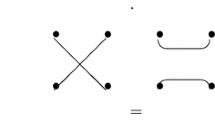Abstract
We construct combinatorial (involutory) Gelfand models for the following diagram algebras in the case when they are semi-simple: Brauer algebras, their partial analogues, walled Brauer algebras, their partial analogues, Temperley-Lieb algebras, their partial analogues, walled Temperley-Lieb algebras, their partial analogues, partition algebras and their Temperley-Lieb analogues.
Similar content being viewed by others
References
R. Adin, A. Postnikov, Y. Roichman. Combinatorial Gelfand models. J. Algebra 320 (2008), no. 3, 1311–1325.
Adin R., Postnikov A., Roichman Y.: A Gelfand model for wreath products. Israel J. Math. 179, 381–402 (2010)
J. Araujo. A Gelfand model for a Weyl group of type B n . Beiträge Algebra Geom. 44 (2003), no. 2, 359–373.
J. Araujo, J. Bigeón. A Gelfand model for the symmetric generalized group. Comm. Algebra 37 (2009), no. 5, 1808–1830.
J. Araujo, T. Bratten. Gelfand models for classical Weyl groups. Preprint arXiv:1112.3585.
G. Benkart, T. Halverson. Motzkin Algebras. Preprint arXiv:1106.5277.
Bernstein J., Gelfand I., Gelfand S.: of representations of compact Lie groups, Funktsional. Anal. i Prilozhen. 9, 61–62 (1975)
R. Brauer. On algebras which are connected with the semisimple continuous groups. Ann. of Math. (2) 38 (1937), no. 4, 857–872.
F. Caselli. Involutory reflection groups and their models. J. Algebra 324 (2010), no. 3, 370–393.
F. Caselli, R. Fulci. Refined Gelfand models for wreath products. European J. Combin. 32 (2011), no. 2, 198–216.
F. Caselli, R. Fulci. Gelfand models and Robinson-Schensted correspondence. J. Algebraic Combin. 36 (2012), no. 2, 175–207.
S. Garge, J. Oesterlé. On Gelfand models for finite Coxeter groups. J. Group Theory 13 (2010), no. 3, 429–439.
O. Ganyushkin, V. Mazorchuk, Classical finite transformation semigroups, An introduction. Algebra and Applications, Vol. 9, Springer Verlag, 2009.
O. Ganyushkin, V. Mazorchuk, B. Steinberg, On the irreducible representations of a finite semigroup, Proc. Amer. Math. Soc. 137 (2009), no. 11, 3585-3592.
T. Halverson. Characters of the centralizer algebras of mixed tensor representations of \({GL(r,\mathbb{C})}\) and the quantum group \({U_q(\mathfrak{gl}(r,\mathbb{C}))}\) . Pacific J. Math. 174 (1996), 359–410.
T. Halverson, M. Reeks. Gelfand Models for Diagram Algebras. Preprint arXiv:1302.6150.
N. Inglis, R. Richardson, J. Saxl. An explicit model for the complex representations of S n. Arch. Math. (Basel) 54 (1990), no. 3, 258–259.
V. Jones. The Potts Model and the symmetric group, in Subfactors: Proceedings of the Tanaguchi Symposium on Operator Algebras, Kyuzeso, 1993, pp. 259–267, World Scientific, River Edge, NJ 1994.
V. Kodiyalam, D.-N. Verma. A natural representation model for symmetric groups. Preprint arXiv:math/0402216.
S. König, Ch. Xi. A characteristic free approach to Brauer algebras. Trans. Amer. Math. Soc. 353 (2001), no. 4, 1489–1505.
K. Koike. On the decomposition of tensor products of the representations of classical groups: by means of universal characters. Adv. Math. 74 (1989), 57–86.
G. Kudryavtseva, V. Mazorchuk. Combinatorial Gelfand models for some semigroups and q-rook monoid algebras. Proc. Edinb. Math. Soc. (2) 52 (2009), no. 3, 707–718.
P. Martin. Temperley-Lieb algebras for nonplanar statistical mechanics–the partition algebra construction. J. Knot Theory Ramifications 3 (1994), no. 1, 51–82.
P. Martin. Potts models and related problems in statistical mechanics. Series on Advances in Statistical Mechanics, 5. World Scientific Publishing Co., Inc., Teaneck, NJ, 1991.
P. Martin, V. Mazorchuk. Partitioned binary relations. Preprint arXiv:1102.0862, to appear in Math. Scand.
P. Martin, V. Mazorchuk. On the representation theory of partial Brauer algebras. Preprint arXiv:1205.0464. To appear in Quart. J. Math.
P. Martin, H. Saleur. Algebras in higher-dimensional statistical mechanics – the exceptional partition (mean field) algebras. Lett. Math. Phys. 30 (1994), no. 3, 179–185.
Mazorchuk V.: On the structure of Brauer semigroup and its partial analogue. Problems in Algebra 13, 29–45 (1998)
V. Mazorchuk. Endomorphisms of \({\mathfrak{B}_n}\) , \({\mathcal{P}\mathfrak{B}_n}\) and \({\mathfrak{C}_n}\) . Comm. Algebra 30 (2002), no. 7, 3489–3513.
Nikitin P.: The centralizer algebra of the diagonal action of the group \({GL_n(\mathbb{C})}\) in a mixed tensor space. J. Math. Sci. 141, 1479–1493 (2007)
R. Paget. Representation theory of q-rook monoid algebras. J. Algebraic Combin. 24 (2006), no. 3, 239–252.
H. Rui. A criterion on the semisimple brauer algebras. J. Comb. Theory Ser. A 111 (2005), no. 1, 78–88.
B. Sagan, The symmetric group. Representations, combinatorial algorithms, and symmetric functions. Second edition. Graduate Texts in Mathematics, 203. Springer-Verlag, New York, 2001.
M. Schramm. Combinatorial Gelfand models. Master Thesis. Uppsala University, 2012.
H. Temperley, E. Lieb. Relations between the “percolation” and “colouring” problem and other graph-theoretical problems associated with regular planar lattices: some exact results for the “percolation” problem. Proc. Roy. Soc. London Ser. A 322 (1971), no. 1549, 251–280.
Turaev V.: Operator invariants of matrices and R-matrices. Izv. Akad. Nauk SSSR 53, 1073–1107 (1989)
Author information
Authors and Affiliations
Corresponding author
Rights and permissions
About this article
Cite this article
Mazorchuk, V. Combinatorial Gelfand Models for Semisimple Diagram Algebras. Milan J. Math. 81, 385–396 (2013). https://doi.org/10.1007/s00032-013-0206-2
Received:
Published:
Issue Date:
DOI: https://doi.org/10.1007/s00032-013-0206-2




